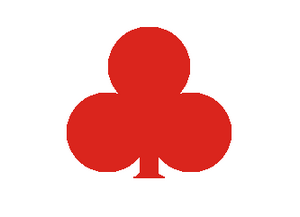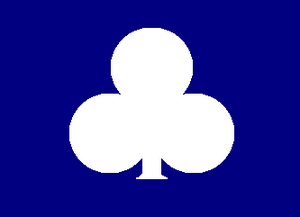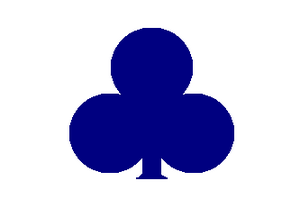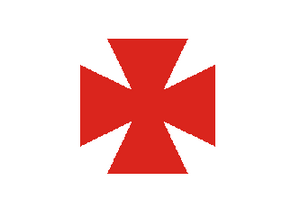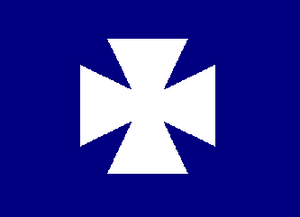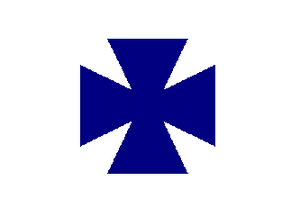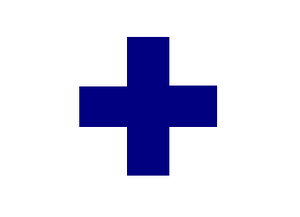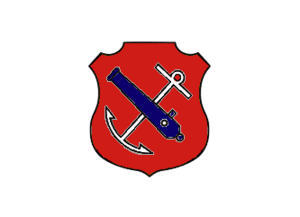Appomattox campaign Union order of battle facts for kids
The Union Army was the main army for the United States during the American Civil War. This article lists the different groups and leaders who were part of the Union Army during the Appomattox campaign. This was a very important series of battles that led to the end of the war. The information here comes from how the army was set up during that time. You can find out about the Confederate army's setup in a separate article.
Contents
Understanding the Ranks
When you see these short forms, they mean:
- LTG = Lieutenant General (a very high rank)
- MG = Major General
- BG = Brigadier General
- Col = Colonel
- Ltc = Lieutenant Colonel
- Maj = Major
- Cpt = Captain
- Lt = Lieutenant
Other short forms you might see:
- w = wounded (got hurt in battle)
- mw = mortally wounded (got hurt very badly and later died)
- k = killed in action (died in battle)
Union Forces: The Main Commanders
The overall commander of the Union forces was LTG Ulysses S. Grant. He was in charge of all the armies.
His main helper was BG Seth Williams, who was the Assistant Adjutant General.
For protection, Grant had:
- The 5th U.S. Cavalry (Companies B, F, and K), led by Cpt Julius W. Mason.
- The 4th U.S. Infantry as Headquarters Guard, led by Cpt Joseph B. Collins.
The Army of the Potomac
This was one of the biggest Union armies, led by MG George G. Meade.
Headquarters and Support Units
These units helped the main army run smoothly.
- Provost Guard: Led by Bvt BG George N. Macy. This group included cavalry and infantry regiments like the 1st Indiana Cavalry and the 3rd Pennsylvania Cavalry. They helped keep order.
- Independent Brigade: Led by Bvt BG Charles H. T. Collis. This brigade had units like the 1st Massachusetts Cavalry and the 80th New York Infantry.
- Headquarters Guard: The 3rd U.S. Infantry, led by Cpt Richard G. Lay, protected the main command center.
- Quartermaster's Guard: This group, including the Independent Company, Oneida (New York) Cavalry, led by Cpt James E. Jenkins, protected supplies.
Engineers
Engineers were very important for building bridges and roads.
- Engineer Brigade: Led by BG Henry W. Benham. This included the 15th New York Engineers and 50th New York Engineers.
- Other engineers: A special Battalion of U.S. engineers was led by Maj Franklin Harwood.
Artillery
Artillery units used cannons and big guns. BG Henry J. Hunt was in charge of the artillery.
- Siege Train: Led by Bvt BG Henry L. Abbot. This group had heavy artillery like the 1st Connecticut Heavy Artillery.
- Artillery Reserve: Led by BG William Hays. This included many light artillery batteries from states like Maine, New York, and Ohio.
II Corps
This corps was led by MG Andrew A. Humphreys.
- First Division: Led by Bvt MG Nelson A. Miles. This division had four brigades with regiments from Michigan, New Hampshire, New York, and Pennsylvania.
- Second Division: Led by BG William Hays, then BG Thomas A. Smyth, and later Bvt MG Francis C. Barlow. This division also had three brigades with regiments from many states, including Maine, Massachusetts, and New York.
- Third Division: Led by Bvt MG Gershom Mott, then BG Régis de Trobriand. This division had three brigades with regiments from Indiana, Maine, New York, and Pennsylvania.
- Artillery Brigade: Led by Ltc John G. Hazzard. This brigade had light artillery batteries from Massachusetts, New Hampshire, New Jersey, and New York.
V Corps
This corps was led by MG Gouverneur K. Warren, and later Bvt MG Charles Griffin.
- Escort: The 4th Pennsylvania Cavalry, Company C protected the corps leaders.
- Provost Guard: The 104th New York Volunteer Infantry kept order within the corps.
- First Division: Led by Bvt MG Charles Griffin, then Bvt MG Joseph J. Bartlett. This division had three brigades with regiments from New York, Pennsylvania, Maine, and Michigan. A famous leader here was BG Joshua L. Chamberlain.
- Second Division: Led by Bvt MG Romeyn B. Ayres. This division had three brigades with regiments from New York, Maryland, and Delaware.
- Third Division: Led by Bvt MG Samuel W. Crawford. This division had three brigades, including the famous Iron Brigade, with regiments from New York, Wisconsin, Maine, and Pennsylvania.
- Artillery Brigade: Led by Bvt BG Charles S. Wainwright. This brigade had artillery batteries from New York and U.S. Artillery units.
VI Corps
This corps was led by MG Horatio G. Wright.
- Escort: The 21st Pennsylvania Cavalry, Company E, protected the corps leaders.
- First Division: Led by Bvt MG Frank Wheaton. This division had three brigades with regiments from New Jersey, Connecticut, New York, Pennsylvania, Rhode Island, and Wisconsin.
- Second Division: Led by Bvt MG George W. Getty. This division had three brigades, including the Vermont Brigade, with regiments from New York, Pennsylvania, Vermont, and Maine.
- Third Division: Led by BG Truman Seymour. This division had two brigades with regiments from New Jersey, New York, Pennsylvania, Ohio, and Maryland.
- Artillery Brigade: Led by Maj Andrew Cowan. This brigade had artillery batteries from New Jersey, New York, Rhode Island, and U.S. Artillery units.
IX Corps
This corps was led by MG John G. Parke.
- Provost Guard: The 79th New York Volunteer Infantry served as the corps' police force.
- First Division: Led by Bvt MG Orlando B. Willcox. This division had three brigades with regiments from Michigan, New York, Pennsylvania, Wisconsin, and Maryland.
- Second Division: Led by Bvt MG Robert B. Potter, then BG Simon G. Griffin. This division had two brigades with regiments from Massachusetts, New Jersey, New York, Pennsylvania, Rhode Island, Maine, and New Hampshire.
- Third Division: Led by BG John F. Hartranft. This division had two brigades with regiments from Pennsylvania.
- Artillery Brigade: Led by Bvt BG John C. Tidball. This brigade had many artillery batteries from Maine, Massachusetts, New Jersey, New York, and Pennsylvania.
- Cavalry: The 2nd Pennsylvania Cavalry was attached to this corps.
Cavalry Corps (under Army of the Potomac)
This cavalry division was led by MG George Crook.
- 1st Brigade: Led by Bvt MG Henry E. Davies, Jr.. This brigade had cavalry from New Jersey, New York, and Pennsylvania.
- 2nd Brigade: Led by Bvt BG John Irvin Gregg, then Col Samuel B. M. Young. This brigade had cavalry from Pennsylvania.
- 3rd Brigade: Led by Bvt BG Charles H. Smith. This brigade had cavalry from Maine, New York, and Ohio.
The Army of the James
This army was led by MG Edward O. C. Ord. His Chief of Staff was Bvt BG Theodore Read.
Headquarters and Support Units
- Headquarters guards: Included units from the 3rd Pennsylvania Heavy Artillery.
- Engineers: The 1st New York Volunteer Engineer Regiment helped with construction.
- Pontoniers: The 3rd Regiment Massachusetts Volunteer Heavy Artillery, Company I, specialized in building pontoon bridges.
- Unattached Cavalry: Various cavalry units, including the 4th Massachusetts Volunteer Cavalry and 5th Regiment Massachusetts Colored Volunteer Cavalry, were directly under army command.
Defenses of Bermuda Hundred
This area was defended by MG George L. Hartsuff.
- Infantry Division: Led by Bvt MG Edward Ferrero. This division had two brigades with regiments from New York, Pennsylvania, and heavy artillery units.
- Separate Brigade: Led by BG Joseph B. Carr. This brigade was spread out to defend specific forts and landings in Virginia, including Fort Pocahontas and Harrison's Landing. It included units from New Jersey, New York Cavalry, and U.S. Colored Cavalry.
- Artillery: Led by Bvt BG Henry L. Abbot. This included various New York and Pennsylvania artillery batteries.
XXIV Corps
This corps was led by MG John Gibbon.
- Headquarters Guard: The 4th Massachusetts Cavalry, Companies F and K, protected the corps leaders.
- First Division: Led by BG Robert S. Foster. This division had three brigades with regiments from Illinois, Ohio, Pennsylvania, Connecticut, Maine, Massachusetts, and New York.
- Third Division: Led by BG Charles Devens. This division had three brigades with regiments from Connecticut, New Hampshire, New York, Wisconsin, Maryland, and Pennsylvania.
- Independent Division: Led by Bvt MG John W. Turner. This division had three brigades with regiments from Massachusetts, Ohio, Illinois, Pennsylvania, and West Virginia.
- Artillery: Led by Maj Charles C. Abell. This brigade had artillery batteries from New York, Pennsylvania, Rhode Island, and U.S. Artillery units.
XXV Corps
This corps was led by MG Godfrey Weitzel.
- Provost Guard: The 4th Massachusetts Cavalry, Companies E & H, served as the corps' police.
- First Division: Led by Bvt MG August V. Kautz. This division had three brigades and an attached brigade, mostly made up of United States Colored Troops (African American soldiers). It also had the 2nd U.S. Colored Troops Cavalry.
- Second Division: Led by BG William Birney. This division had three brigades, also mostly made up of U.S. Colored Troops.
- Artillery Brigade: Led by Cpt Loomis L. Langdon. This brigade had artillery batteries from Connecticut, New Jersey, Pennsylvania, Rhode Island, and U.S. Artillery units.
Cavalry Corps (under Army of the James)
This cavalry division was led by BG Ranald S. Mackenzie.
- 1st Brigade: Led by Col Robert M. West. This brigade included the 5th Pennsylvania Cavalry and New York Cavalry units.
- 2nd Brigade: Led by Col Samuel P. Spear, then Col Andrew W. Evans. This brigade included the 1st District of Columbia Cavalry, 1st Regiment Maryland Volunteer Cavalry, and 11th Pennsylvania Cavalry.
- Artillery: The 4th Independent Battery Wisconsin Light Artillery provided artillery support.
The Army of the Shenandoah
This army was led by MG Philip H. Sheridan. His Chief of Staff was Col James Forsyth.
Cavalry Corps
This cavalry corps was led by MG Wesley Merritt.
- First Division: Led by BG Thomas C. Devin. This division had three brigades, including the Michigan Brigade, with cavalry from Michigan, New York, Pennsylvania, and U.S. Cavalry units.
- Artillery: The 4th U.S. Artillery, Battery C & Battery E provided artillery support.
- Third Division: Led by Bvt MG George A. Custer. This division had three brigades with cavalry from Connecticut, New Jersey, New York, Ohio, Vermont, and West Virginia.
See Also
Images for kids


